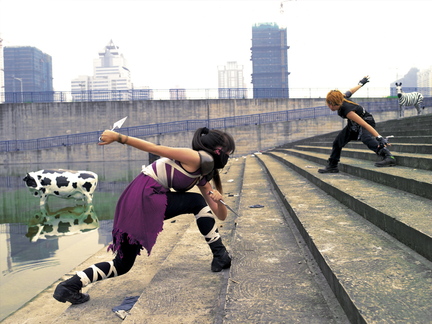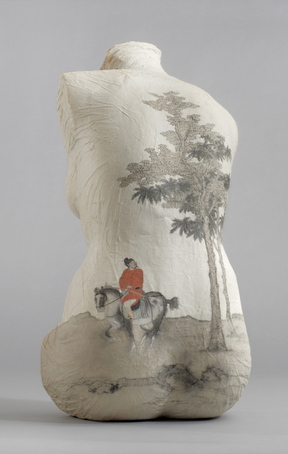“Breakthrough: Work by Contemporary Chinese Women Artists” is one of the year’s best exhibitions in Maine. It addresses some vastly complicated issues without dumbing them down while managing to be an engaging show that is very easy to enjoy.
The exhibition was co-curated by Bowdoin’s Shu-Chin Tsui, associate professor of Asian Studies and film studies, and Peggy Wang, assistant professor of art history and Asian studies. But it was backed by a team ranging from post-doctoral curatorial fellow Sarah Montross and the museum’s professional staff to student assistants.
This kind of scholarly support allows shows like this and Colby’s extraordinary “Spaces & Places: Chinese Art from the Lunder-Colville Collection and the Museum of Fine Arts, Boston” to gain open-ended momentum: They expansively open doors rather than closing in on one version of “truth.”
But “Breakthrough” has much less in common with “Spaces & Places” than with UNE’s recently completed year-long series “Maine Women Pioneers III.”
To its advantage, however, “Breakthrough” doesn’t co-mingle with the community it purports to survey (in fact, it doesn’t even try to be a survey), and the Bowdoin project was undertaken with significantly more resources (academic personnel, museum facilities, money, etc.).
But these two complex exhibitions make each other better. Their differences reveal much about their subject cultures as well as the plight of women within them. (If you missed “MWP,” there is a catalog available, and my reviews of all four installments are online.)
The simplest premise of “Breakthrough” is the question, “Why are there relatively so few women artists in China?” Some responses immediately reflect back onto us. For example, when Wang notes in the catalog that “In the 1980s, few women entered into art academies,” I first think of Western practices like primogeniture (the custom of having the oldest male inherit a family’s entire estate – so education resources would be focused on him).
One of the gutsiest points the show takes on is the “feminist” label and why some (Chinese) “female artists bristle at this category and deny its applicability altogether.” This is a question that came up repeatedly with the “MWP” series and Maine female artists like Lauren Fensterstock. (It’s not something we have the space to discuss here, but it’s a fundamentally important conversation.)
Fortunately, the handsome catalog (short enough to read on site – and it’s free!) raises many such questions succinctly while providing a wealth of information about the artists.
Viewers are greeted by Peng Wei’s “Autumn of the Tang Dynasty” – a beautiful work made from paper molded around a mannequin torso on which a traditional scene has been painted. As a straight (white) male, I wound up questioning my response to the work’s sculptural beauty (literally formed on a mannequin’s shape), but that only led me to appreciate the work more.
It’s a fine introductory work because it establishes the overarching metaphor of the woman’s body as both subject and object in contemporary art.
There are only 22 works in two rooms, but they are nicely installed and they achieve more than sufficient density without overwhelming the viewer.
The strongest presence in the first room comprises Chen Qiulin’s video “Peach Blossom” and the large-scale photographs from the project in which a fully-gowned bride revisits her hometown that had been devastated by an earthquake (despite the Olympics-hosting-minded government’s insistence that all had been made well). The images eloquently move past the obvious forced-urbanization-as-disease reading toward ideas about tradition and the “old” (discarded industrial sites, say, versus traditional dress for a traditional wedding – all, mind you, in a Western idiom).
The bride is like the flowers that bloom in the decayed landscape – it’s a Ying/Yang idea that life will sprout from its opposite. While we may see her as nightmarishly dislocated, a Buddhist will likely see her as the first blossoming bud of renewal.
Hung Liu’s paintings also speak with unusual cultural eloquence. In her “Relic 8,” we see two “nineteenth-century courtesans, quoted from a historical photograph” surrounded by luck symbols painted in a bold contemporary hand. In this case, the female has taken herself from subject of the (male) gaze to the image’s painterly author.
Cao Fei’s virtual-world “RMB City” video, in which the artist creates (and then destroys) an island city using the online platform “Second Life,” is fascinating. The artist’s avatar (virtual identity – the norm now for children who play online games) and its relation to her cultural and fantasy lives leads to many questions – both disturbing and empowering.
Fei’s photographs of COSplayers (adolescents who, in the real world, dress up like manga and anime characters – think Pokemon or Naruto) are my favorite works in the show. They show the empowering effects of self-presentation and role-playing as they begin to trump their obvious roots in fantasy play.
There are other worthy works in “Breakthrough,” but they stand on their own and are well-represented by label copy and the catalog. It’s not all successful, however; for example, Cai Jin’s visceral rotting banana leaf paintings don’t do it for me. And the fact that many of the works are associated with fancy NYC galleries raises questions about their authenticity as voices raised to speak for marginalized society. But together, all of these works help distill provocative questions about the status and role of women in culture.
“Breakthrough” is absolutely one of Maine’s best shows of 2013.
Freelance writer Daniel Kany is an art historian who lives in Cumberland. He can be contacted at:dankany@gmail.com
Send questions/comments to the editors.






Comments are no longer available on this story